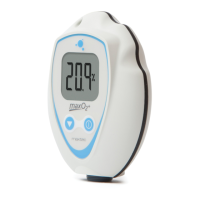4
MANUFACTURED BY MAXTEC.
1. Connect the Tygon tubing to the bottom of the
analyzer by threading the barbed adapter onto
the oxygen sensor. (figure 2)
2. Attach the other end of the sample hose to
the sample gas source and initiate flow of the
sample to the unit at a rate of 1-10 liters per
minute (2 liters per minute is recommended).
3. Using the “ON/OFF” key, make sure the
unit is in the power “ON” mode.
4. Allow the oxygen reading to stabilize. This will normally
take about 30 seconds or more.
2.2 Calibrating the MAXO
2
®
+
Oxygen Analyzer
The MAXO
2
+
Analyzer should be calibrated upon initial power-up. Thereafter,
Maxtec
®
recommends calibration on a weekly basis. To serve as a reminder,
a one week timer is started with each new calibration. At the end of one week
a reminder icon “ ” will appear on the bottom of the LCD. Calibration is
recommended if the user is unsure when the last calibration procedure was
performed, or if the measurement value is in question.
Start calibration by pressing the button for more than 3 seconds. The
MAXO
2
+
will automatically detect if you are calibrating with 100% or 20.9%
oxygen (normal air). Do not attempt to calibrate to any other concentration.
100% O
2
verification, new calibration is required when:
• The measured O
2
percentage in 100% O
2
is below 99.0% O
2.
• The measured O
2
percentage in 100% O
2
is above 101.0% O
2.
• The CAL reminder Icon is blinking at the bottom of the LCD.
• If you are unsure about the displayed O
2
percentage. (see Factors
influencing accurate readings.)
Compressed air (20.9% O
2
), new calibration is required when:
• The measured O
2
percentage in 20.9% O
2
is below 19.9% O
2.
• The measured O
2
percentage in 20.9% O
2
is above 21.9% O
2.
• The CAL reminder Icon is blinking at the bottom of the LCD.
• If you are unsure about the displayed O
2
percentage.
(see Factors influencing accurate readings.)
Calibrate with the same type of circuit and flow that you will use when taking
your readings.
FIGURE 2

